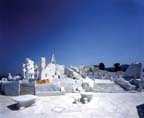

In Japan, the spectacular “Hill of Hope†in Hiroshima, a park and a temple dedicated to “the Mother,†is all made of pure White Carrara marble. And Italian materials and technology (primarily from Tuscany) have been largely used to build the new museums of Nagasaki and Shizuoka in Japan, squares and buildings in Singapore, Korea, Taiwan and virtually anywhere there is a building site at work in the Middle East.
A group of extraordinary architects and craftsmen who worked on these projects had been selected in Beijing, China, and disclosed in Florence, Italy, as the winners of the 21st Marble Architectural Awards (MAA 2005), which is presented each year by Internazionale Marmi e Macchine (IMM) Carrara and ICE, in conjunction with the Ministry of Foreign Affairs, the Region of Tuscany and Toscana Promozione, and with the aid of the bank Cassa di Risparmio di Carrara.
The award - honoring foreign architects who use Italian marble and other stone - was this year open to buildings erected in the Far East and to their Italian suppliers.
A press conference was initially held at the Faculty of Architecture of Florence University several months prior to CarraraMarmotec, which took place this year from June 1 to 4. It was attended by the head of the university degree course in Industrial Design, Massimo Ruffilli; the president of CarraraMarmotec, Giancarlo Tonini; who chaired the MAA jury; and IMM Carrara CEO Paris Mazzanti. An award ceremony was later held during the stone exhibition.
The Marble Architectural Awards are part of an intensive promotional campaign that IMM Carrara has been carrying out for a long time with the Italian Trade Commission (ICE) and Toscana Promozione. In addition to Tonini, the international jury also included architect Fan Xue for the Chinese Architects' Society; professor Qin Youguo, head of the Faculty of Architecture of the Tsinghua University in Beijing; and Antonino Laspina, manager of the Beijing branch of ICE. This panel reviewed a total of 53 designs before reaching a decision on the winners.
The award program consists of three sections: External Facings, Interior Design and Urban Landscape. In the “Exterior Facings†section, Japanese architects Yoshinori Chidori and Kengo Kuma won for the design of the new Arts Museum of the Prefecture of Nagasaki, Japan, which opened in 2004. An award was given for the same building to Campolonghi Italia Srl, based in Montignoso Massa, Italy, for its custom-made materials and technical assistance.
The Special Mentions in this category included the firms Nihonsekkei in Japan and Kohn Pedersen Fox Associates of the U.S. for its design of the Nihonbashi Building skyscraper in Tokyo, Japan, which was also built with the assistance of Campolonghi; Chinese architect Wang Lu, who designed the Museum of Tiantai; and to the firm Raymond Woo & Associates Architects for the Equity Plaza skyscraper in Singapore, Malaysia, made of materials supplied by IMEG, based in Viareggio, Italy.
In the “Interior Design†category, the top award was given to Pei Partnership Architects LLP for the headquarters of the New Bank of China in Beijing and to its suppliers Furrer S.p.A. of Carrara, Italy, and Mariotti Carlo & Figli of Tivoli, Italy. A Special Mention went to DP Architects and Michael Wilford & Partners, the designers of the Esplanade, the new music center of Singapore, Malaysia. This made lavish use of Italian travertine and Pietra Dorata designs - supplied by Savema and TSS Europe, both of Pietrasanta.
Lastly, two equal First Prizes were awarded to two Japanese architects in the “Urban Landscape†section. Kazuto Kuetani won for the landscape design of the “Hill of Hope†in Hiroshima - materials supplied by Marmi Galleria Ravaccione of Carrara - and Junzo Munemoto won for the Sculpture Garden, a spectacular outdoor museum of Shizuoka, Japan, dedicated to Tuscan sculptor Giuliano Vangi.